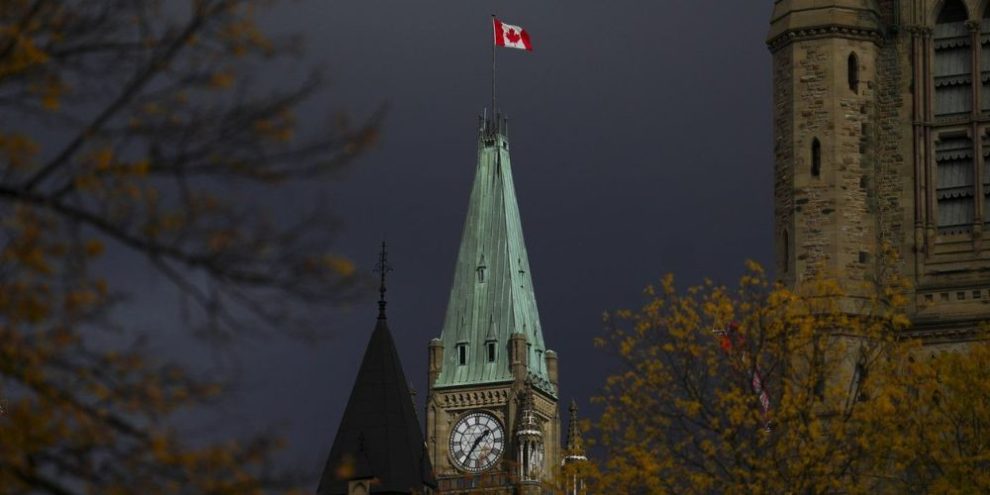
The Canadian economy topped expectations with a sharp rebound in the third quarter as a stronger trade balance helped fuel the recovery from a tariff-driven contraction.
Statistics Canada said Friday that real gross domestic product rose 2.6 per cent on an annualized basis in the third quarter of 2025. That’s well above expectations from both the Bank of Canada and a poll of economists heading into the release for 0.5 per cent annualized growth.
The figures mark a rebound from a contraction at an annualized rate of 1.8 per cent in real GDP for the second quarter as U.S. tariffs took hold on the Canadian economy. Those results were revised two tenths of a point lower from earlier StatCan reports.
BMO chief economist Doug Porter said in a note to clients Friday that while the headline growth rate was a pleasant surprise, the details were more mixed, with a pullback in imports driving the gain.
Barrie's News Delivered To Your Inbox
By submitting this form, you are consenting to receive marketing emails from: Central Ontario Broadcasting, 431 Huronia Rd, Barrie, Ontario, CA, https://www.cobroadcasting.com. You can revoke your consent to receive emails at any time by using the SafeUnsubscribe® link, found at the bottom of every email. Emails are serviced by Constant Contact
Exports edged up 0.2 per cent in the three months from July to September, coming off a steep drop of 7.0 per cent from April to June as U.S. tariffs took full effect. Imports meanwhile fell 2.2 per cent in the segment’s sharpest drop since the fourth quarter of 2022, pushing GDP higher.
Dragging on growth last quarter was a decline in household spending — thanks largely to fewer purchases of passenger vehicles — and a slower accumulation in manufacturing inventories.
Domestic demand, which encompasses all spending in an economy from consumers, governments and businesses, was slightly negative in the third quarter.
"The data were going to be noisy this quarter coming off the trade shock in Q2, so what's important here is to look at the flat performance for domestic demand, and it paints the subdued picture we expected," TD Bank senior economist Andrew Hencic said in a note.
Porter pointed out that revisions recorded Friday to the 2022, 2023 and 2024 GDP results also show overall growth in those years was ratcheted up by a combined 1.4 percentage points.
StatCan cautioned that its third-quarter GDP figures may be subject to larger revisions than usual thanks to the recent U.S. government shutdown. Because the agency relies on U.S. customs information for its merchandise trade inputs, StatCan had to produce a special estimate for its September figures to substitute traditional data sources hampered by the shutdown.
Growth in government capital spending also helped fuel growth in the third quarter, the agency said, particularly thanks to an 82 per cent jump in spending on weapon systems from the previous quarter.
The resale housing market was also heating up somewhat in the third quarter of the year, offset by a drop-off in construction.
Canada’s stats authority also reported Friday that real GDP rose 0.2 per cent in September, a tick higher than its initial estimates and more than offsetting a drop of 0.1 per cent in August.
The manufacturing industry led growth in September, while the transportation and warehousing sector saw a rebound as travel activity recovered from the Air Canada flight attendants strike the previous month.
But StatCan’s early estimates for October suggest a downbeat start to the fourth quarter.
The agency said it expects real GDP fell 0.3 per cent in the month as results from oil and gas extraction, educational services and manufacturing point to losses. Those preliminary figures will be revised with the formal release of October GDP in December.
The third quarter GDP results come ahead of the Bank of Canada’s last scheduled interest rate decision of the year on Dec. 10.
The central bank cut its benchmark interest rate by a quarter point to 2.25 per cent in October but signalled it may be done lowering the policy rate unless economic data strays from its forecast.
The Bank of Canada called for modest growth of 0.75 per cent annualized in the second half of 2025 and recovering slowly in the years to come.
Bradley Saunders, North America economist at Capital Economics, said in a note that the import-led growth in Q3 masks underlying weakness in domestic demand.
The drop-off in household spending was the largest quarterly decline outside the pandemic in almost two decades, Saunders said.
"The declines in household consumption and business investment, along with the weak preliminary GDP estimate for October, demonstrate how the economy is struggling for momentum," he said.
"Absent a sharp rebound in November, this leaves growth on track to underperform the Bank of Canada’s forecast."
Porter said the rebounding Q3 figure should at least quiet "recession chatter" for now as revisions to the previous years' GDP results point to a more resilient Canadian economy than first expected.
"For the Bank of Canada, there are many mixed messages here, but the overall read is better than expected, thus more firmly putting them on the sidelines for next month's meeting," he said.
This report by The Canadian Press was first published Nov. 28, 2025.





